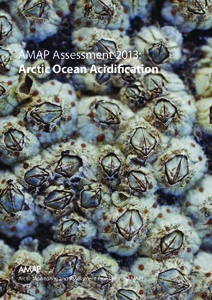| dc.coverage.spatial | Arctic Region | en_US |
| dc.coverage.spatial | Arctic Ocean | en_US |
| dc.date.accessioned | 2020-01-07T21:51:46Z | |
| dc.date.available | 2020-01-07T21:51:46Z | |
| dc.date.issued | 2013 | |
| dc.identifier.citation | AMAP (2013) AMAP Assessment 2013: Arctic Ocean Acidification. Oslo, Norway, Arctic Monitoring and Assessment Programme (AMAP), 111pp. DOI: http://dx.doi.org/10.25607/OBP-712 | en_US |
| dc.identifier.isbn | 978-82-7971-082-0 | |
| dc.identifier.uri | http://hdl.handle.net/11329/1195 | |
| dc.identifier.uri | http://dx.doi.org/10.25607/OBP-712 | |
| dc.description.abstract | This assessment report presents the results of the 2013 AMAP
Assessment of Arctic Ocean Acidification (AOA). This is the
first such assessment dealing with AOA from an Arctic-wide
perspective, and complements several assessments that AMAP
has delivered over the past ten years concerning the effects of
climate change on Arctic ecosystems and people.
The Arctic Monitoring and Assessment Programme (AMAP) is
a group working under the Arctic Council. The Arctic Council
Ministers have requested AMAP to:
•• produce integrated assessment reports on the status and
trends of the conditions of the Arctic ecosystems;
•• identify possible causes for the changing conditions;
•• detect emerging problems, their possible causes, and the
potential risk to Arctic ecosystems including indigenous
peoples and other Arctic residents; and to
•• recommend actions required to reduce risks to
Arctic ecosystems.
This report provides the accessible scientific basis and validation
for the statements and recommendations made in the Arctic
Ocean Acidification Assessment Summary for Policy-makers1
that was delivered to Arctic Council Ministers at their meeting
in Kiruna, Sweden in May 2011 and the related AMAP State
of the Arctic Environment report Arctic Ocean Acidification
2013: An Overview2. It includes extensive background data and
references to the scientific literature, and details the sources
for figures reproduced in the overview report. Whereas the
Summary for Policy-makers report contains recommendations
that focus mainly on policy-relevant actions concerned with
addressing the consequences of AOA, the conclusions and
recommendations presented in this report also cover issues
of a more scientific nature, such as proposals for filling gaps
in knowledge, and recommendations relevant to future
monitoring and research work.
The AOA assessment was conducted between 2010 and 2013 by
an international group of over 60 experts. Lead authors were
selected based on an open nomination process coordinated
by AMAP. A similar process was used to select international
experts who independently reviewed this report.
Information contained in this report is fully referenced and
based first and foremost on peer-reviewed and published
results of research and monitoring undertaken since 2006.
It also incorporates some new (unpublished) information
from monitoring and research conducted according to wellestablished
and documented national and international
standards and quality assurance/ quality control protocols. Care
has been taken to ensure that no critical probability statements
are based on non-peer-reviewed materials.
Access to reliable and up-to-date information is essential for
the development of science-based decision-making regarding
ongoing changes in the Arctic and their global implications. The
AOA assessment summary reports1,2 and films have therefore
been developed specifically for policy-makers, summarizing the
main findings of the AOA assessment. The AOA lead authors
have confirmed that both this report and its derivative products
accurately and fully reflect their scientific assessment. The
AOA reports and the films are freely available from the AMAP
Secretariat and on the AMAP website: www.amap.no, and their
use for educational purposes is encouraged.
AMAP would like to express its appreciation to all experts who
have contributed their time, efforts and data, in particular the
lead authors who coordinated the production of this report.
Thanks are also due to the reviewers who contributed to the
AOA peer-review process and provided valuable comments
that helped to ensure the quality of the report. A list of the
main contributors is included at the start of each chapter. The
list is not comprehensive. Specifically, it does not include the
many national institutes, laboratories and organizations, and
their staff, which have been involved in various countries in
AOA-related monitoring and research. Apologies, and no lesser
thanks are given to any individuals unintentionally omitted
from the list.
The support from the Arctic countries and non-Arctic countries
implementing research and monitoring in the Arctic is vital to
the success of AMAP. The AMAP work is essentially based on
ongoing activities within these countries, and the countries that
provide the necessary support for most of the experts involved
in the preparation of the AMAP assessments. In particular,
AMAP would like to acknowledge Norway for taking the leadcountry
role in this assessment and thank Canada, Norway,
Sweden, USA and the Nordic Council of Ministers for their
financial support to the AOA work.
The AMAP Working Group is pleased to present its assessment
to the Arctic Council and the international science community. | en_US |
| dc.language.iso | en | en_US |
| dc.publisher | Arctic Monitoring and Assessment Programme (AMAP) | en_US |
| dc.rights | Attribution 4.0 International | * |
| dc.rights.uri | http://creativecommons.org/licenses/by/4.0/ | * |
| dc.subject.other | Ocean acidification | en_US |
| dc.subject.other | Carbon dioxide | |
| dc.title | AMAP Assessment 2013: Arctic Ocean Acidification. | en_US |
| dc.type | Report | en_US |
| dc.description.status | Published | en_US |
| dc.format.pages | 111pp. | en_US |
| dc.contributor.corpauthor | Arctic Monitoring and Assessment Programme (AMAP) | en_US |
| dc.description.refereed | Refereed | en_US |
| dc.publisher.place | Oslo, Norway | en_US |
| dc.subject.parameterDiscipline | Parameter Discipline::Chemical oceanography::Carbonate system | en_US |
| dc.description.currentstatus | Current | en_US |
| dc.description.sdg | 14.3 | en_US |
| dc.description.eov | Inorganic carbon | en_US |
| dc.description.bptype | Manual (incl. handbook, guide, cookbook etc) | en_US |
| obps.contact.contactemail | amap@amap.no | |
| obps.resourceurl.publisher | www.amap.no | en_US |
 Repository of community practices in Ocean Research, Applications and Data/Information Management
Repository of community practices in Ocean Research, Applications and Data/Information Management

